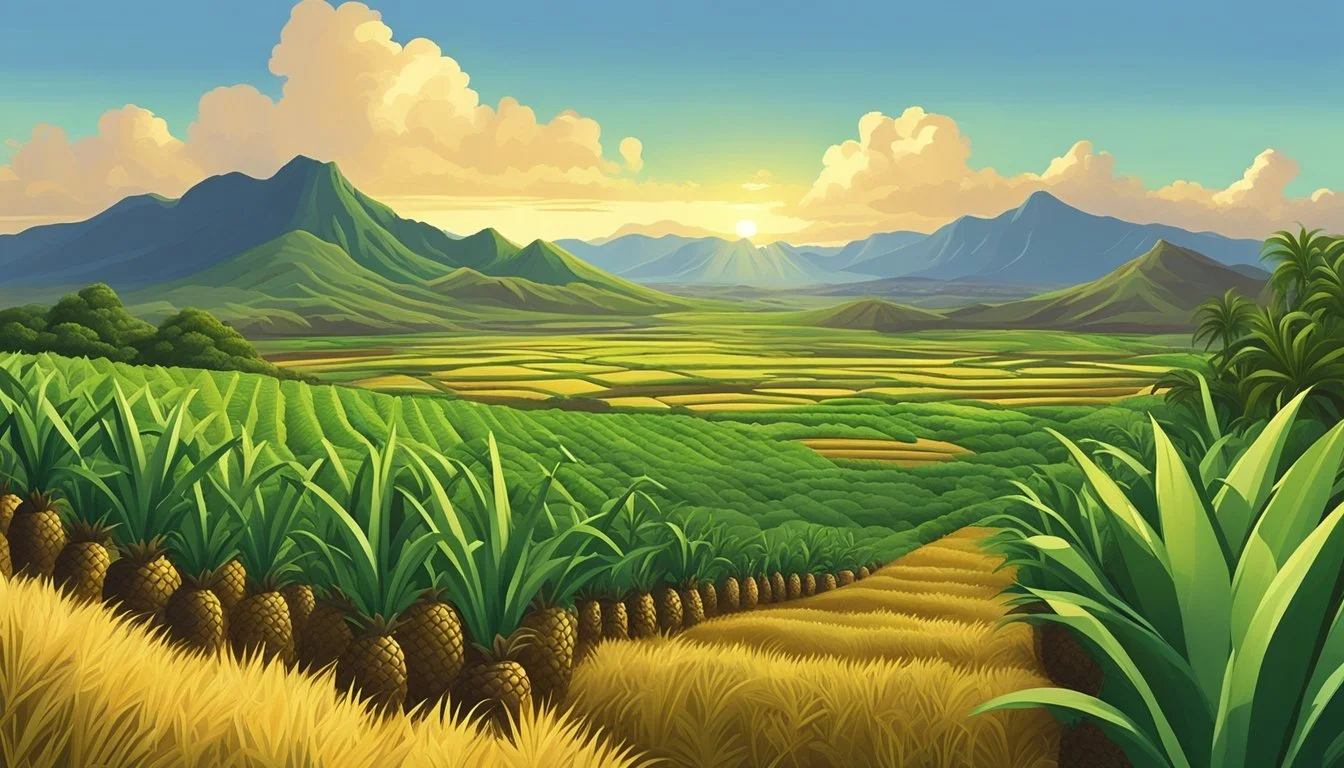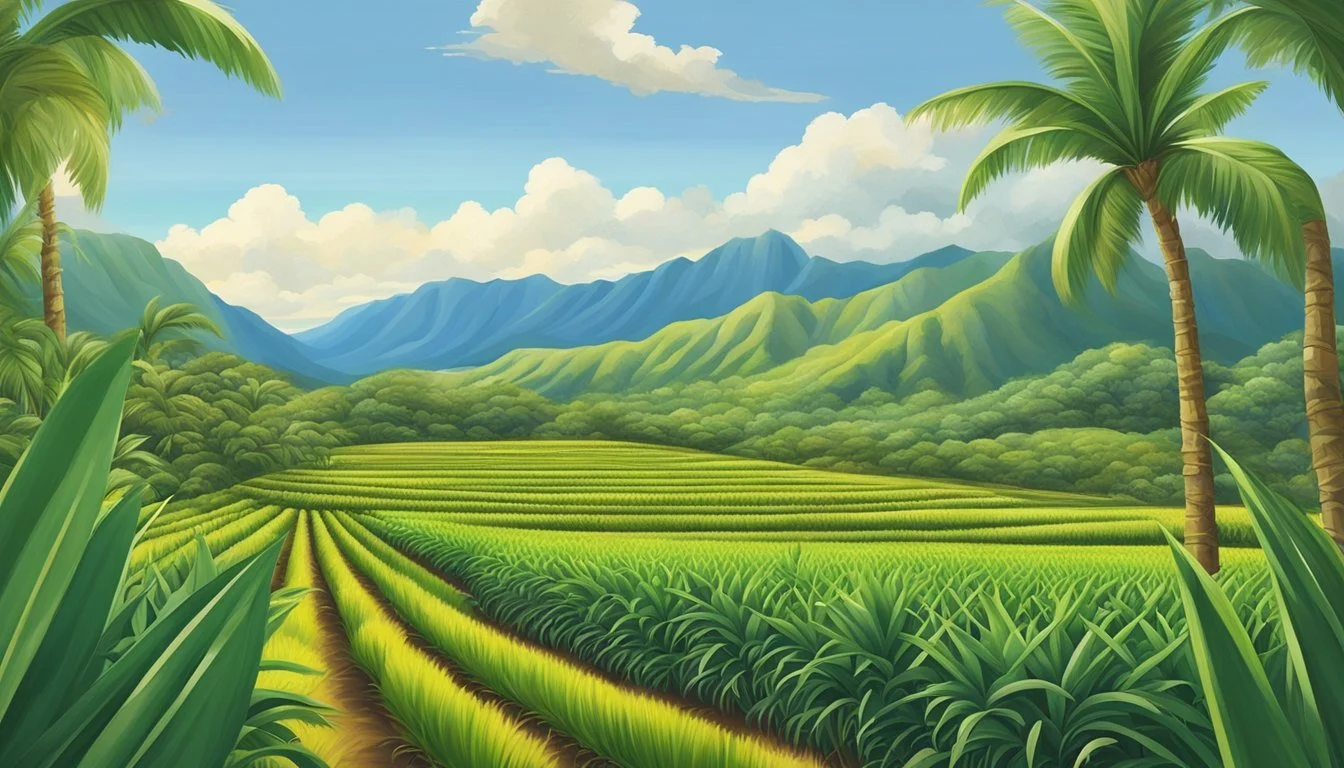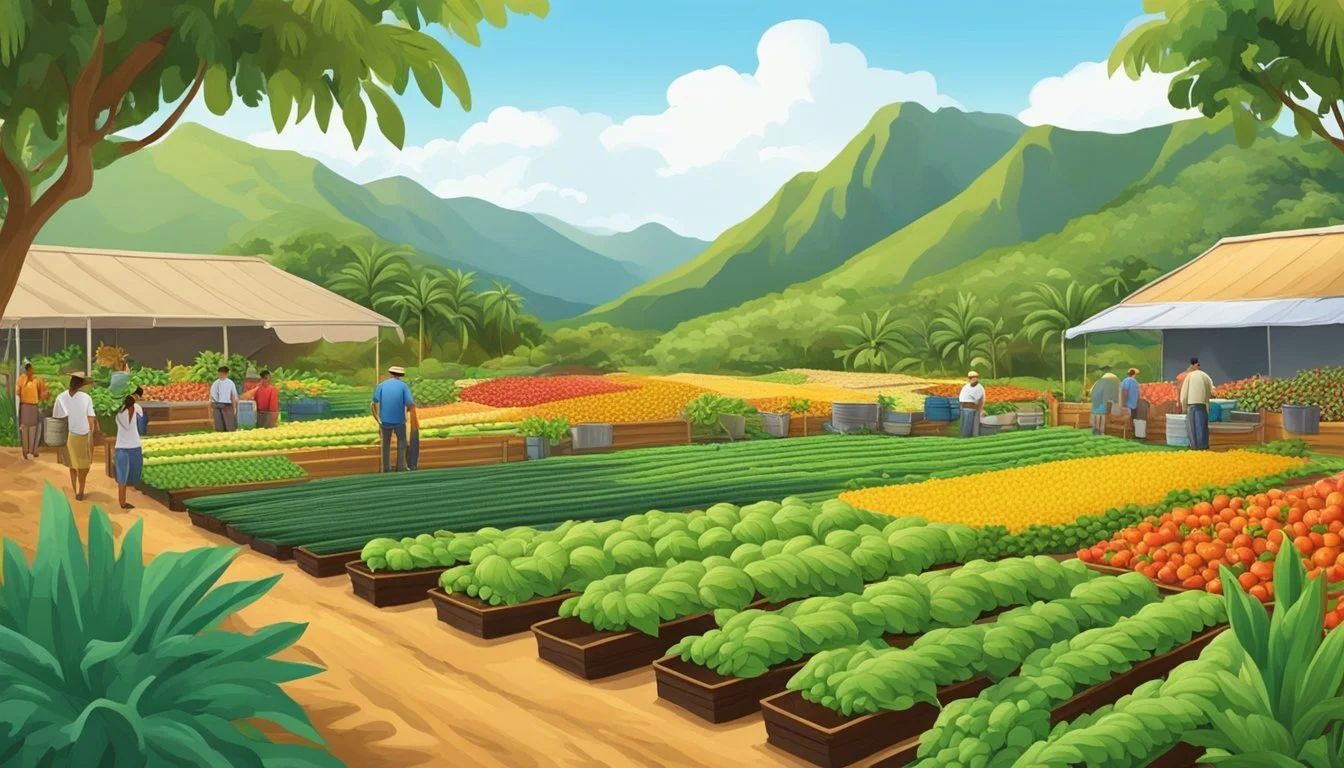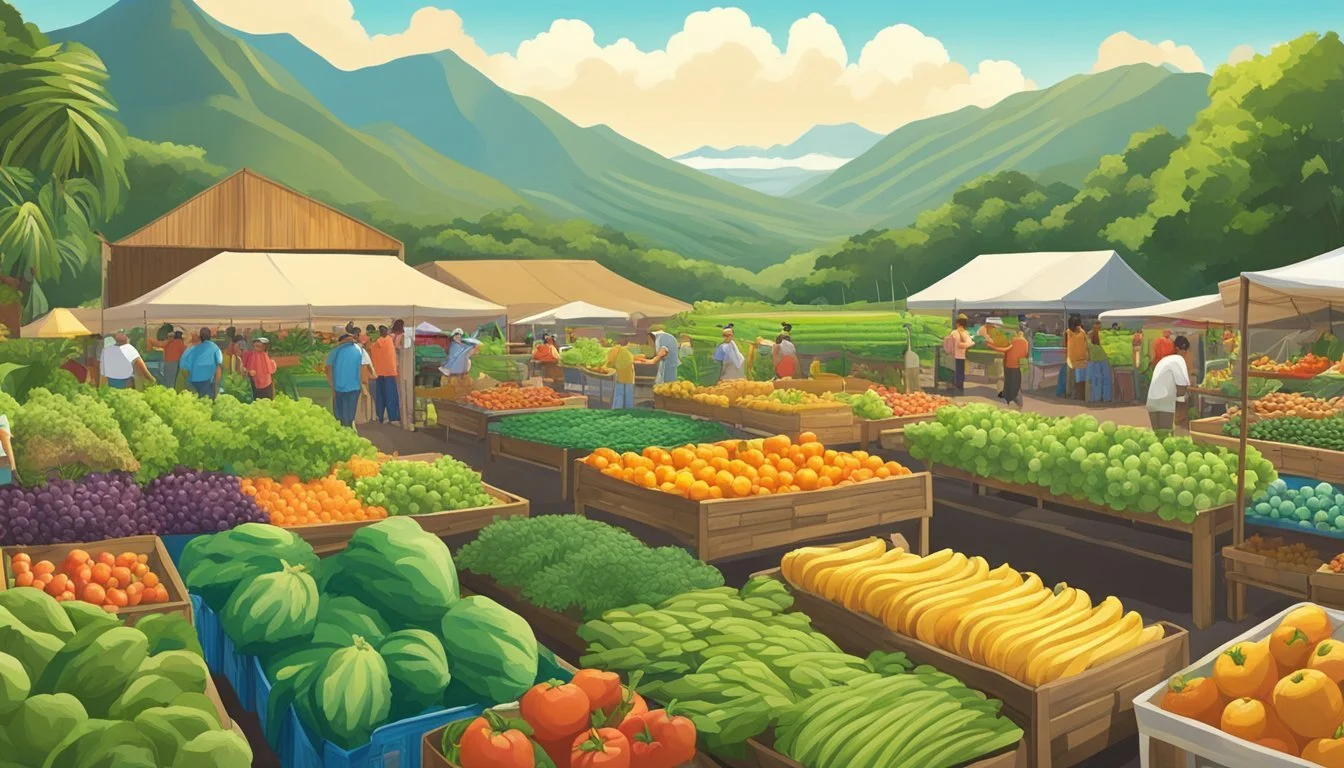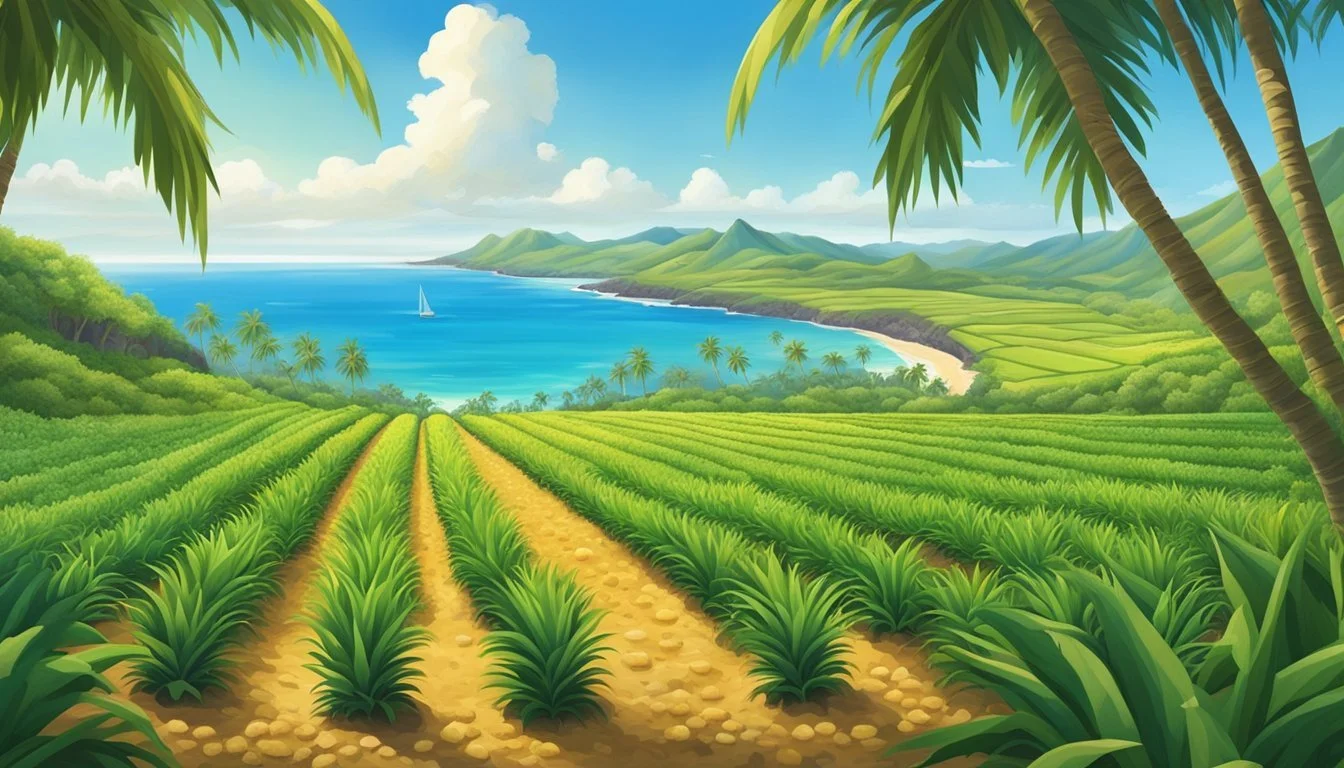Guide to Farming in Hawaii
Essential Tips for Tropical Agriculture
This Article is Part of Our State by State Farming Guide
Venturing into the agricultural landscape of Hawaii presents a unique opportunity, blending the islands' rich volcanic soil with a growing interest in sustainable and local food production. In Hawaii, farming is not just an occupation but a way of contributing to the community and the state's self-sufficiency. Prospective farmers in this region often face a steep learning curve, encompassing everything from crop selection suited to Hawaii's microclimates to understanding intricate market demands.
The path to successful farming in Hawaii necessitates strategic planning, an acquisition of pertinent skills, and a thorough grasp of the state's agricultural regulations. With the landscape characterized by both small family-run farms and larger agribusinesses, the state offers a variety of resources designed to support and educate new entrants in the sector. These resources provide valuable guidance on how to access capital, land, and navigate the complexities of marketing locally grown products effectively.
Agriculture in Hawaii is not without its challenges, including pest management and the need for continuous innovation. However, the state's commitment to fostering a robust farming community is evident through its various support mechanisms for local farmers. This includes research into new crops that can thrive in Hawaii's environment, ensuring that the farming industry continues to evolve alongside the changing economic and ecological landscape.
Understanding Hawaii's Agricultural Landscape
Hawaii's unique setting presents a blend of opportunities and challenges for local agriculture, which fundamentally influences both the state's economy and its food security.
Climate and Soil Conditions
Hawaii's diverse microclimates range from tropical to temperate, which allows for a variety of crops to be grown year-round. The soil is typically fertile, especially in areas where volcanic ash is prevalent. However, climate change is introducing greater variability, with more intense weather events and shifting precipitation patterns impacting farming cycles and crop viability. This places stress on water resources and necessitates adaptive farming practices.
Local Farming Practices and Challenges
The farming practices in Hawaii are as diverse as its crops, from farms cultivating traditional taro to modern coffee plantations. Local farmers often utilize sustainable methods, such as agroforestry, which align with traditional Hawaiian values of land stewardship. However, they face barriers such as high land costs, limited availability of agricultural land, and complex land lease issues. The cost of imports for necessary farm inputs adds to the challenges, making sustainability a key concern for Hawaiian farmers.
Economic Impact of Agriculture in Hawaii
Agriculture contributes significantly to Hawaii's economy and its cultural preservation. While large-scale plantations of pineapple and sugar have declined, the focus has shifted to smaller operations that contribute to the diversity of the state's agricultural outputs. Despite this, less than 1% of the state's budget is dedicated to agriculture, underlining the need for greater investment to address the hurdles faced by local farmers and to enhance food security.
Getting Started with Farming in Hawaii
Starting a farm in Hawaii requires careful planning and access to the right resources. The journey involves setting clear goals, choosing crops well-suited to the climate, and securing financial aid to sustain operations.
Acquiring Land and Resources
Farmers must locate suitable land with access to critical infrastructure necessary for farming operations. Whether through purchasing or leasing, the viability of the land is paramount, considering soil quality, water availability, and climate. They should ensure compliance with state rules and regulations during this process.
Land Acquisition Options:
Lease: Land leases are often more accessible for those starting out.
Purchase: Demands a substantial initial investment but provides ownership.
Key Resources:
Water: Vital for crop cultivation.
Soil Quality: A soil test is essential for determining suitability for intended crops.
Climate: Understanding microclimates is critical in selecting locations.
Selecting Suitable Crops for Cultivation
One must select crops that thrive in Hawaii's unique climate zones. Crops like taro, various fruits, coffee, and specialty vegetables can be lucrative but require specific conditions to flourish.
Climate Considerations:
Tropical
Subtropical
Popular Crops:
Fruit (e.g., Papaya, Banana)
Coffee
Specialty Vegetables
Understanding and Securing Financial Aid
Prospective farmers should explore loans and grants tailored to agricultural businesses. Assistance from federal and state programs can be a substantial aid in covering the start-up costs of a farm in Hawaii.
Financial Aid Types:
Loans: To cover extensive costs such as land or equipment.
Grants: May be available for sustainable and organic farming practices.
Starting Assistance:
Business Planning: Agencies offer training in creating strategic and business plans.
Marketing: Guidance on effectively marketing produce is often provided.
Key Agricultural Products of Hawaii
Hawaii's agricultural landscape is rich with a variety of crops that thrive in its unique tropical climate. Among these, coffee, particularly from the Kona region, and tropical fruits like papayas are some of its most celebrated exports.
Coffee Cultivation and Kona Coffee
Hawaii is the only state in the US that produces coffee commercially. The volcanic soil and ideal climatic conditions, especially on the Big Island, give rise to the renowned Kona coffee. This coffee variety is highly sought after for its rich flavor profile. Kona coffee is cultivated on the slopes of Mauna Loa and Hualalai in the North and South Kona Districts.
Coffee Varieties: Mostly Arabica coffee, including the prized Kona coffee.
Harvesting Period: August to January.
Tropical Fruit Production
Islands like Maui and Oahu are abundant with tropical fruits, contributing significantly to Hawaii's agrarian economy. Papaya is a standout crop, known for its sweet taste and health benefits. Additionally, farms across Hawaii cultivate other tropical fruits that are both consumed domestically and exported.
Primary Fruits: Papayas, pineapples, bananas, and guavas.
Cultivation Areas: Kula on Maui for papaya, and North Shore of Oahu for a variety of fruits.
Specialized Crop Cultivation
Hawaii is also home to a variety of specialized crops that benefit from its rich, volcanic soil and warm climate. Crops like macadamia nuts, vanilla, and cacao form a significant part of the agricultural offerings. These crops have adapted well to Hawaii's environment and are integral to the state's farming identity.
Cultivation Insights:
Macadamia Nuts: Primarily grown on the Big Island.
Vanilla: Grown in greenhouse settings; the Hawaiian vanilla orchid requires hand-pollination.
Cacao: The basis for Hawaiian chocolate, cultivated on all main islands.
In conclusion, Hawaii's key agricultural products such as coffee, tropical fruits, macadamia nuts, vanilla, and cacao are emblematic of its farming heritage and contribute significantly to the local and export markets, upheld by the state's favorable agricultural conditions.
Sustainable Farming and Food Security
In Hawaii, sustainable farming practices and advancements in agricultural technology are key to enhancing food security. With innovative approaches, the islands are poised to overcome the challenges of modern-day food production.
Promoting Sustainability in Agriculture
Hawaii's agricultural sector recognizes the significance of sustainable practices. Farmers are increasingly adopting methods that preserve the environment while producing food. These include crop rotation, organic farming, and the use of native plants to maintain biodiversity. Organizations like the Hawaii Organic Farming Association are at the forefront, educating and advocating for these sustainable practices.
Crop rotation improves soil health and reduces pests.
Organic farming eliminates harmful chemicals, promoting eco-friendliness.
Advancements in Agricultural Technology
Technology plays a pivotal role in Hawaii's agricultural landscape, with innovative solutions being introduced to improve efficiency and yield. Farmers are using precision farming tools and data analytics to make smarter decisions about resource allocation. Moreover, the development of more robust and productive crop varieties is enhancing the islands' ability to provide for themselves.
Precision farming tools help optimize water and fertilizer use.
Data analytics ensure that crop production is managed effectively.
Food Sovereignty Initiatives
Food security in Hawaii encompasses more than just producing enough food; it involves achieving food sovereignty, where locals have control over their food sources. Efforts are underway to grow at least 50% of staple crops locally to safeguard against potential supply disruptions. This initiative will leverage a new wave of local agricultural workers and technologies to create a resilient food system.
Local production of staple crops like rice and ulu is imperative.
Community involvement in food production strengthens food sovereignty.
Marketing and Selling Agricultural Products
Successful marketing and selling of agricultural products in Hawaii hinge on effective branding, knowledge of local and export markets, and active community engagement. These components help farmers maximize their profitability and ensure the sustainability of their operations.
Branding and Promotion Strategies
In Hawaii's diverse agricultural scene, branding is crucial. A strong brand distinguishes Hawaiian products such as Kona coffee or Maui pineapples. Promotion strategies often involve storytelling, connecting consumers emotionally to the land (aina) and the unique aspects of Hawaii's climate and culture that contribute to the product's quality.
Online Presence: A user-friendly website and active social media can showcase products and share the farm's story.
Packaging: Incorporates Hawaiian themes, quality seals, or certifications to indicate authenticity and origin.
Farm Branding Elements: Could include logos, slogans, or images that reflect Hawaiian heritage and the quality of the products.
Local and Export Markets
Hawaiian farmers have access to local food markets like farmers' markets, which are pivotal for selling fresh produce directly to consumers. The export market is also significant for Hawaiian agriculture due to the islands' unique produce.
Local: Selling at community farmers' markets, through Community Supported Agriculture (CSA), or to local restaurants.
Export: Navigating regulatory requirements for exporting, especially for value-added products like coffee or macadamia nuts.
Community Engagement and Education
Community engagement through farm tours and agricultural education programs strengthens the connection between farmers and consumers. Farm tours offer a hands-on experience and educate the public on farming practices and the importance of supporting local agriculture.
Workshops: Hosted by farmers or agricultural organizations to teach sustainable farming methods and business strategies.
School Visits: Farms can host school groups, offering educational experiences that promote agriculture as a viable career path.
By focusing on these areas, Hawaiian agricultural producers can build strong brands, tap into local and international demand, and foster community support.
Support and Resources for Farmers
Hawaii offers a wealth of support and resources for farmers, from educational programs rooted in the state’s unique agricultural conditions to a robust network of associations and access to funding opportunities aimed at fostering a thriving agricultural sector.
Educational Programs and Mentorship
The University of Hawaii, through its College of Tropical Agriculture and Human Resources (CTAHR), provides extensive educational resources aimed at promoting sustainable agrarian practices. Aspiring farmers can benefit from programs that offer both theoretical knowledge and practical mentorship, catering to the unique farming landscape of Hawaii. Notably, the university often facilitates mentorship opportunities, pairing experienced farmers with newcomers to share valuable insights and hands-on guidance.
Agricultural Associations and Networks
Hawaii's farmers can join a variety of agricultural associations, which offer networking opportunities, collective marketing, and the sharing of best practices. These organizations often play a pivotal role in supporting the state's agribusiness. For instance, the Hawaii Organic Farming Association connects organic farmers and promotes organic farming methods. Additionally, networks such as the Hawaii Seed Growers Network bring together artisanal farmers focusing on locally grown and adapted seeds, cultivating a community dedicated to the state’s agricultural diversity.
Government and Private Grants
Both the government and private institutions provide grants that are instrumental for farmers starting or expanding their operations. These financial resources aim to lower the barriers to entry and encourage investment in agribusiness ventures. Access to capital through such grants allows farmers to secure land, invest in infrastructure, and market their products effectively. Grant programs are often detailed in guidebooks tailored to Hawaii’s specific agricultural landscape, equipping farmers with the financial support needed to navigate the business side of farming successfully.
Challenges and Opportunities in Hawaiian Agriculture
Hawaiian agriculture faces unique difficulties ranging from environmental factors to market pressures, but it also holds remarkable potential for growth and innovation in sustainable practices.
Dealing with Pests and Diseases
Pests and diseases pose significant threats to Hawaiian agriculture. The islands' ecosystem is particularly vulnerable due to its isolation, and endemic species can be severely impacted by introduced pests. For instance, pests like the coffee borer beetle harm crops and can necessitate increased use of pesticides, which can have environmental consequences. Disease outbreaks also challenge farmers, potentially affecting staple crops and diminishing yields.
Impact of Global Events on Local Farming
Global events such as the recent pandemic have disrupted supply chains, making it clearer than ever that local farming is essential for food security. Hawaii's reliance on imports has led to a renewed interest in supporting local agriculture, yet these events underscore the vulnerability of the islands' food systems. Farmers had to adapt rapidly to changing market demands, with some, like the Hawaiian Vanilla Co., finding new ways to reach consumers.
Innovation and Growth Potential
Hawaii presents a significant growth potential in agriculture, particularly in niche markets. Innovations in farming practices open up opportunities for sustainability and economic gain. The Ocean Rider Seahorse Farm is an example of successful aquaculture that caters to both environmental conservation and tourism. Such innovative ventures highlight the potential for unique agricultural enterprises in Hawaii that can set a precedent for other regions.
Fostering the Next Generation of Farmers
Hawaii's agriculture sector is actively engaging and supporting new entrants, focusing on cultivating youth interest, imparting essential farming skills, and ensuring generational continuity in the farming industry.
Youth Involvement in Farming
Youth participation is pivotal for the sustainability of farming in Hawaii. Initiatives such as GoFarm Hawaii aim to inspire a passion for agriculture among the younger demographic by exposing them to farming culture and operations. They provide opportunities to learn about both traditional farming techniques and modern agricultural practices. Programs like the Farm Apprentice Mentoring (FAM) Program enable hands-on experiences that integrate indigenous knowledge, an approach critical for those who will shape Hawaii's agricultural future.
Building Farming Skills and Knowledge
Developing skills and knowledge is indispensable for budding farmers. Comprehensive training programs in Hawaii are tailored for different experience levels, from novices to those with a burgeoning interest in the field. Courses cover the gamut from soil health and crop production to agricultural business management. The emphasis on food security and agricultural self-sufficiency aligns with the state's strategy to boost local food production, thereby facilitating the growth of skilled farmers who can contribute effectively to the community and economy.
Succession Planning for Farming Legacies
To ensure longevity, Hawaii's agricultural sector encourages succession planning. This involves cultivating the next generation to take over and innovate on existing farms. It's a strategic way to preserve the legacies of established farmers, providing a seamless transition that integrates new blood into the sector without losing valuable heritage and experience. This approach supports both the skills transfer and the sustenance of passion for farming, critical for the continuity of both small and family-owned farms that form the backbone of Hawaii's agricultural industry.


